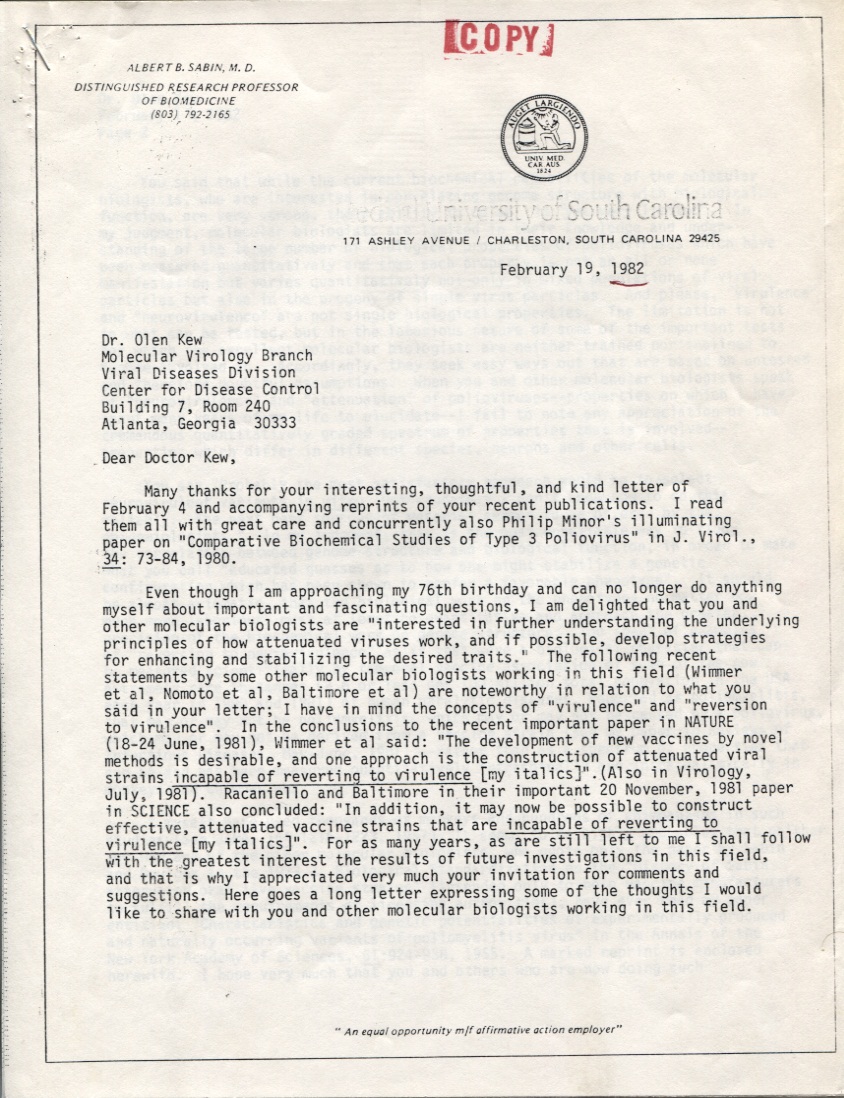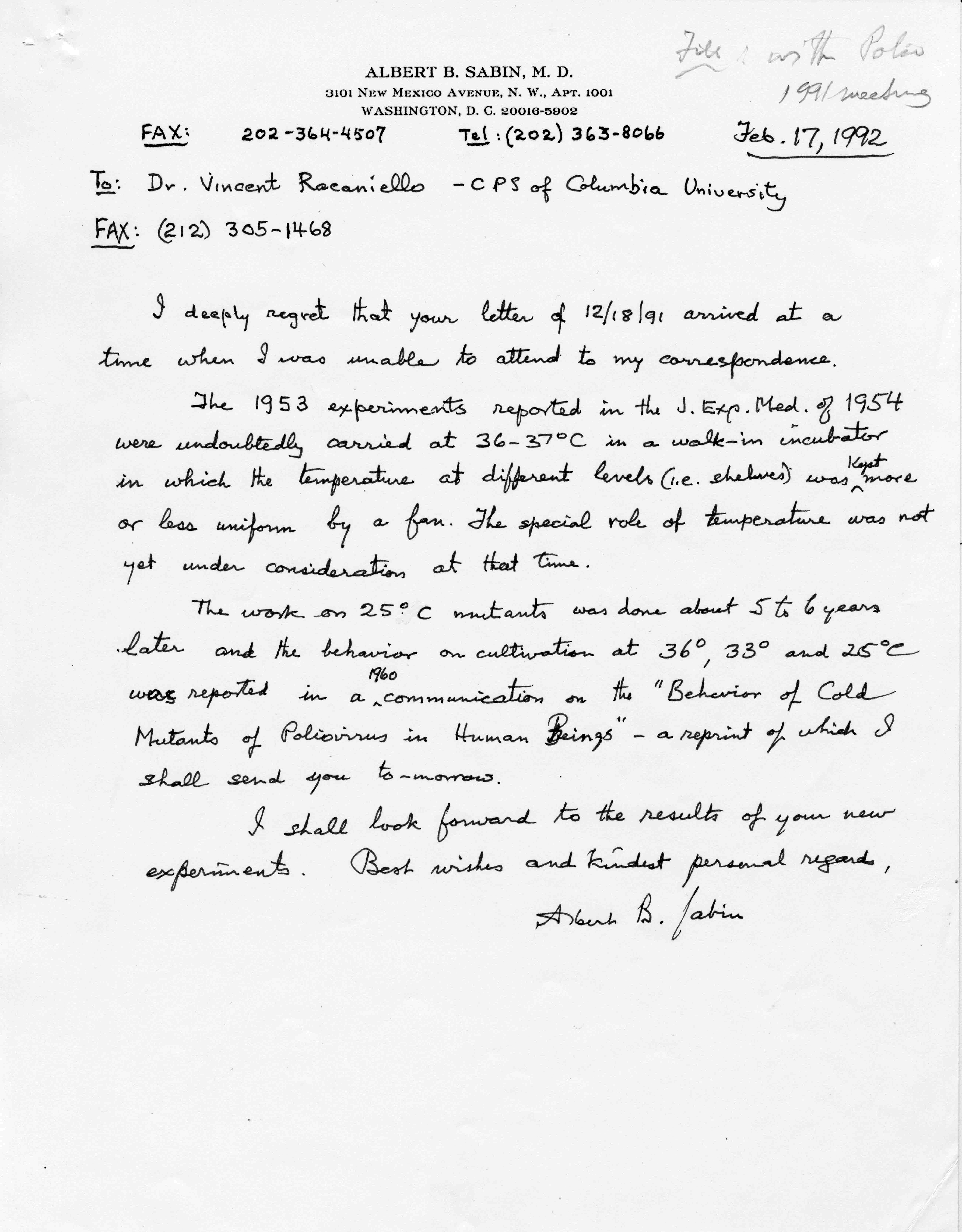
This is the first page of the 1982 letter from Dr. Sabin to Dr. Kew, which Dr. Racaniello refers to in his article.
Recently I received a Google alert for an article that mentioned Dr. Sabin. The article was about a live debate on H5N1 viruses sponsored by the New York Academy of Sciences, and it briefly discussed Dr. Vincent Racaniello’s opinion on using ferrets as “models of flu effects in humans.” According to the article, “when [Dr. Racaniello] began studying viral pathogenesis under Albert Sabin and other eminent experts, ‘The first thing they said was when you study viruses in animals, don’t think you’ll learn much about what happens in humans.’”
Since Dr. Racaniello specifically mentioned Dr. Sabin, I thought I would do a little bit of research on their connection. This led me to a 1993 article by Dr. Racaniello that appeared in an issue of Biologicals dedicated to Dr. Sabin. I found Dr. Racaniello’s discussion of how Dr. Sabin influenced his research quite interesting, so I thought I would share some of the materials that he refers to in the article.
According to the article, Dr. Racaniello met Dr. Sabin in March of 1983 at the International Symposium on Poliomyelitis Control in Washington DC. However, Dr. Racaniello knew of Dr. Sabin and his opinions prior to this meeting because of a February 1982 letter written from Dr. Sabin to Dr. Olen Kew at the Centers for Disease Control. Dr. Sabin sent around the letter to several of his colleagues, including Dr. David Baltimore, with whom Dr. Racaniello was working at the time. The article summarized Dr. Sabin’s opinion on research by molecular biologists at the time by saying, “Perhaps of greatest interest in the letter was a searing indictment of the inability of molecular biologists to appreciate biological problems.”[1] Dr. Racaniello quoted Dr. Sabin’s letter at length, but a couple lines really stuck out to me:
In my judgment, molecular biologists are limited in their knowledge and understanding of the large number of biological properties of polioviruses […] When you and other molecular biologists speak of “neurovirulence” and “attenuation” of polioviruses – properties on which I have spent many years of my life to elucidate – I fail to note any appreciation of the tremendous quantitatively graded spectrum of properties that is involved…[2]
Dr. Racaniello acknowledged that this letter was influential by writing that the “letter awakened many scientists, including myself, to the complexity of the problem.”[3]
Several years later, Dr. Racaniello sent Dr. Sabin a letter, which included some reprints. In the letter, he wrote, “In retrospect, when I began to work on poliovirus attenuation, I knew very little, but your comments have steered me in the right directions.”[4] Dr. Sabin replied with a handwritten letter, where Dr. Racaniello says that he “incurred [Dr. Sabin’s] wrath.”[5] Dr. Sabin wrote, “It seems to me, that based on the statements in your recent publications, you have either read none of my publications having a bearing on the multiple quantitative phenotypic expressions of individual poliovirus particles and their progeny, or if you did, you didn’t learn anything from them, or you just don’t believe the data that I presented.” Dr. Sabin went on to describe several papers he published and even included a reprint of a paper he published in 1985. He hoped that Dr. Racaniello would read the reprint on the “history of the development and use of my oral poliovirus vaccines” carefully because it might influence future research.[6]
In our collection, we also have a letter that Dr. Sabin faxed to Dr. Racaniello, in reply to a letter regarding the “segregation of attenuated poliovirus variants.” Dr. Sabin’s reply discussed the temperature in different experiments he conducted. He promised to send Dr. Racaniello a reprint of his 1960 report and ended by saying, “I shall look forward to the results of your new experiments.”[7]
In his conclusion, Dr. Racaniello wrote that “the course of [his] work over the years has been influenced by Albert’s suggestions.”[8] Dr. Sabin’s manuscript collection contains many letters between him and other scientists, exchanging ideas and having lively discussions about their differences in opinion. I would like to think that many of these researchers felt the same way about Dr. Sabin and his critiques that Dr. Racaniello did.
References
Note: See Racaniello, V.R., “Infectious cDNA, Cell Receptors, and Transgenic Mice in the Study of Sabin’s Poliovirus Vaccines,” Biologicals 21 (1993): 365-369 for the complete article.
[1] Racaniello, 366.
[2] Letter from Dr. Sabin to Dr. Kew, 19 February 1982. Found in Series 1 – Correspondence, Sub-Series – Individual, Box 14, Folder 11 – Kew, Olen – 1979-1982. (Parts also appear in the Racaniello article.)
[3] Racaniello, 366.
[4] Letter from Dr. Racaniello to Dr. Sabin, 17 July 1991. Found in Series 9 – Poliomyelitis, Sub-Series – Correspondence, Box 6, Folder 12 – General – 1991-1992.
[5] Racaniello, 368.
[6] Letter from Dr. Sabin to Dr. Racaniello, 26 July 1991. Found in Series 9 – Poliomyelitis, Sub-Series – Correspondence, Box 6, Folder 12 – General – 1991-1992. (Parts also appear in Racaniello article.)
[7] Letter from Dr. Racaniello to Dr. Sabin, 18 December 1991, and Dr. Sabin’s 17 February 1992 reply. Both can be found in Series 9 – Poliomyelitis, Sub-Series – Correspondence, Box 6, Folder 12 – General – 1991-1992.
[8] Racaniello, 368.
In 2010, the University of Cincinnati Libraries received a $314,258 grant from the National Endowment for the Humanities (NEH) to digitize the correspondence and photographs of Dr. Albert B. Sabin. This digitization project has been designated a NEH “We the People” project, an initiative to encourage and strengthen the teaching, study, and understanding of American history and culture through the support of projects that explore significant events and themes in our nation’s history and culture and that advance knowledge of the principles that define America. Any views, findings, conclusions, or recommendations expressed in this blog do not necessarily reflect those of the National Endowment for the Humanities.

